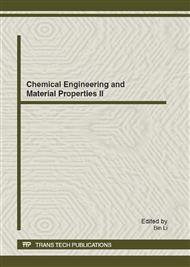p.141
p.147
p.152
p.157
p.161
p.167
p.172
p.177
p.183
Synthesis of M-Toluidine-Aniline Chirality Copolymers Induced by D-Camphorsulfonic Acid
Abstract:
The copolymerization reaction of m-toluidine and aniline has been induced by D-camphorsulfonic acid. When the total concentrations of the acid, the oxidant and the monomer were maintained, the ratio of two types of monomers was varied to realize the structure and property control of m-toluidine-aniline copolymers. FTIR, UV-Vis, CD and SEM were utilized to characterize the products. The results showed that the synthesized copolymers were of fiber and tube structure with the diameter of approximately 70 nm. The introduction of methyl moiety in the molecular chain of benzene weakened the conjugation and blue shifts were observed in both FTIR and UV-Vis spectra. Besides, CD spectra verified the chirality of the copolymers. Negative cotton effect could be discerned at 400 nm and the chirality inversed when [m-An]/[An]=1:5.
Info:
Periodical:
Pages:
161-166
Citation:
Online since:
July 2012
Authors:
Keywords:
Price:
Сopyright:
© 2012 Trans Tech Publications Ltd. All Rights Reserved
Share:
Citation:


